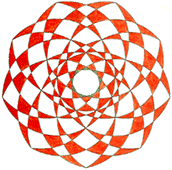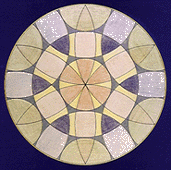|
Praxis für Alternative
Psychosomatik und Traumdeutung, Dr. Remo F. Roth, CH-8001
Zürich
|

|
Remo F. Roth
Dr.
oec. publ., Ph.D.
dipl.
analyt. Psychologe (M.-L. v. Franz)
|

|
©
2002-2004 by Pro Litteris, Zurich, Switzerland and Remo F. Roth,
Horgen-Zurich. All Rights Reserved. dr.remo.roth@psychovision.ch.
Republication and redissemination of the contents of this screen
or any part of this website are expressly prohibited without
prior psychovision.ch written consent.
With many thanks to Gregory Sova, Ph.D.
(LA, CA) for
translation assistance
Book Project:
THE RETURN OF THE WORLD SOUL
Wolfgang Pauli, Carl Jung and the Challenge
of the Unified Psychophysical Reality
© copyright 2002-2004 by
Pro Litteris, Zürich. All rights reserved
This book is
intended for private use only, and is copyrighted under existing Internet
copyright laws and regulations.
back
to Chapter 3, part 4
/ back
to Contents
4.
Neoplatonic and Hermetic alchemy: Eternal infertility versus
incarnation
(part
1)
Contents:
part
1:
4.
Neoplatonic and Hermetic alchemy: Eternal infertility versus
incarnation
4.1
Wolfgang Pauli's differentiation between Neoplatonic and
Hermetic alchemy
4.1.1
A short description of the alchemical opus
4.1.2
Some differences between Neoplatonic and Hermetic
alchemy
part
2:
4.2
Neoplatonic alchemy
4.2.1
The impossibility of transmutation (Wandlung) in the
Neoplatonic opus
4.2.2
The reduction of the quaternity to the Trinity by the early
Medieval Platonist Scotus Eriugena and the Hornberger
Schiessen
4.2.3
Einstein's objective worldview as Hornberger
Schiessen
part 3:
4.3
Hermetic alchemy
4.3.1
Robert Fludd's chymic wedding, the intermediate world and
the infans solaris
part 4:
4.3.2
The symmetry between spirit and matter in Hermetic alchemy
and complementarity
part 5 (will
follow):
4.3.3
Carl Jung's ambivalence between the trinity and the
quaternity and the Axiom of Maria prophetissa: A preliminary analysis
4. Neoplatonic and Hermetic
alchemy: Eternal infertility versus incarnation
(part 1)
4.1 Wolfgang Pauli's differentiation
between Neoplatonic and Hermetic alchemy
4.1.1 A short description of the
alchemical opus
In the previous chapter we found that Pauli's
argument is that Jung's depth psychology was originally conceived as
a natural science, but it began to drift into metaphysics and esoterics because it
projected quaternities into heaven and like this is incapable of
solving the psychophysical problem. Apparently this was as far as
Jung could envision at his time in history. However, we in the 21st
century are left with the task of trying to come to grips with the
psychophysical problem. Therefore we must go on dealing with this
subject.
In the present chapter we will examine more
of Pauli's writings as well as those of the alchemists in the
interest of trying to gain further insight into the solution of the
psychophysical problem. The alchemists have laid down (unconsciously)
a very rich deposit of exploration into the psychophysical problem
over the millenniums and this material must now be thoroughly mined
(consciously) by becoming involved in some of their central
ideas.
One of the most important tasks of alchemy
was the transformation or transmutation of the unrefined into the
refined. The unrefined was the so-called prima materia, the refined
the lapis, the philosopher's stone, the philosophical gold or the
corups subtile (subtle body) which in far-eastern alchemy is the
diamond body . The alchemist's fascination with matter was
compensatory to the too spiritual Christian eon, which demonized the
body (matter) and the feminine principle in general. Of course they
were not consciously aware of why they were so drawn to this effort
and this is why some of their explorations became literal attempts to
make gold. However, the alchemist's work prefigured the task we have
at the start of the 21st century - and that is to consciously realize
the importance of the body, the feminine principle, or Eros
functioning for it is pure gold. Such a conscious realization of the
feminine principle will provide a much needed balancing of the human
psyche and thus how it relates not only to others but also in how it
values and honours the earth and its resources.
One part of the alchemists believed in a
concrete realization of this task and spent their lives trying to
make gold, for example out of lead. Of course they did not succeed,
because their magical attitude of utilizing the alchemical processes
for the literal transformation of concrete matter was wrong. During
the 17th century natural science developed and showed that we can
deal with matter with a causal attitude. As an effect of this greater
consciousness the science of Chemistry was born and the magical
procedures of the concretesized opus were shown as useless. Today,
most scientists think therefore, that this period was pre-scientific
and that we have overcome it with the help of the modern
scientific tools, i.e., quantification and mathematical treatment of
matter.
Besides this concretisizing attitude,
however, there also existed a different branch of alchemical
researchers. These alchemists felt that the process they observed in
their retorts must be interpreted in a symbolic way. This attitude on
the part of these alchemists makes their work of great value to the
modern psychologist because Jung's depth psychology has paved the way
for understanding how to live the symbolic life and thus we are now
able to interpret the symbolism of these alchemists. One part of
these alchemists interpreted their opus using Neoplatonic ideas while
the other part used Hermetic philosophy.
4.1.2 Some differences between
Neoplatonic and Hermetic alchemy
The alchemical process used for the
refinement or distillation of the prima materia into the anima mundi
(i.e., into the world soul - into the body-soul that was hidden in
matter - which was demonized by the Christian eon) or into the subtle
body played an important role in the Hermetic philosophy between the
1st and the 4th century, as well as in Neoplatonism, between the 3rd
and the 6th. Alchemy of the late Middle Ages and at the beginning of
the Renaissance period - in the second half of the 15th and in the
first of the 16th century - incorporated these earlier ideas. As a
consequence, this more modern alchemy has its roots back to the
writings of the founder of Hermetic philosophy, the Egyptian Hermes
Trismegistos and to the Greek Platonism and Neoplatonism of
Plotin.
As we have seen in the previous chapter,
about one and a half years before the foundation of the C.G. Jung
Institute in Zurich, Wolfgang Pauli intensified his research about
the co-founder of modern science, Johannes Kepler, the results of
which he published together with Jung's synchronicity article in 1952
- as the so-called Kepler essay. For the purpose of understanding the
position of Kepler, he had also to engage in its counter-position,
the alchemical ideas.
It was in this time (1946/47) that Pauli
noticed for the first time that the above mentioned two branches of
alchemy, the Neoplatonic on the one hand and the Hermetic on the
other, were totally different.
One of the most important Hermetic alchemists
was the Swiss Medieval physician Paracelsus (1493-1541) . In his book
De Vita longa he describes his opus as a deeply introverted
procedure, in which out of the prima materia of the physical
body a life essence is "distilled". This elixier vitae, which
is equivalent to the lapis, helps for a long and healthy life
in this world, but also for an individual eternal life in the beyond.
This eternal body was also a deified body, which is of course an
absolutely heretical idea for a Christian. Therefore Paracelsus
states: "I also confess that I write like a pagan and yet am a
Christian". [CW 13, § 148]
Paracelsus' ideas were continued by his
gifted student Gerardus Dorneus (2nd half of the 16th century), and
finally by his last follower Robert Fludd (1574-1637). All three were
physicians , in contrast to the Neoplatonists who were mostly
priests. We will deal with them in more detail later.
Especially Robert Fludd will play a very
important role in our investigations. He was involved in an extended
polemic with Johannes Kepler (1571-1630). Therefore Pauli was very
deeply interested in Robert Fludd's thinking, and we will come back
to this alchemist, physician and Rosicrucian many times in our
investigations.
One of the most important differences between
the two philosophies, the Neoplatonic and the Hermetic, occurs in
their relationship to
matter. While the "spiritualizing
philosophers" (Pauli) of Platonism and Neoplatonism consider matter
in principle as something negative and evil, as the snake which they
will "crush the head" ("den Kopf zertreten"), the originally Egyptian
Hermetic show a positive valuation of it. Therefore Pauli
writes:
"Bei Fludd habe ich
wohltuend das Fehlen dieser unangenehmen Tendenz gespürt.
Sein Ziel ist die Coniunctio von licht und dunkel: nicht
die Vergeistigung der Materie, sondern das 'Sonnenkind' in der Mitte
ist das Ziel. Das ist Alchemie im besten Sinne."
[emphasis mine]
English translation:
"With Fludd I felt the
absence of this disagreeable tendency in a beneficial manner. His
goal is the coniunctio of light and dark: not the
spiritualization of matter, but the 'sun's child' in the middle is
the goal. This is alchemy at its best". [translation
and emphasis mine]
Or nine months later:
"Anders als bei den
Platonikern wurde das Licht-Dunkel-Problem von den
Alchemisten des 17. Jahrhunderts eben nicht
verdrängt, und das war und ist es, was mich an Fludd
so fasziniert. [emphasis mine]
English translation:
"Contrary to the Platonist the problem of light and darkness was just not
repressed by the alchemists of the 17th century, and this
is it what fascinates me with Fludd". [translation and
emphasis mine]
As a first result we can therefore conclude
that Pauli is fascinated by the Hermetic idea of the coniunctio, the
(sexual) union of the opposites of light and dark, and of the
Hermetic assumption that these opposites, because of their
equivalence, do not unite in the heaven (or in the Empyreum), but in
a middle sphere, where also the product of this coniunctio, the sun's
child, is born.
Chapter
4, part 2:
See also further articles about
Wolfgang Pauli in
http://www.psychovision.ch/rfr/roth_e.htm
back

10.3.2003
|